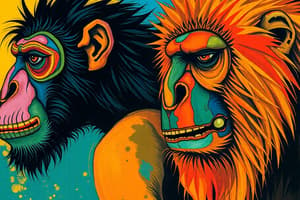Podcast
Questions and Answers
What is the most significant source of information about Denisovans?
What is the most significant source of information about Denisovans?
- DNA evidence (correct)
- Artifacts
- Written records
- Physical remains
Where were Denisovans primarily found?
Where were Denisovans primarily found?
- Africa
- Asia (correct)
- Europe
- Australia
What is the most likely reason that no formal species name has been established for Denisovans?
What is the most likely reason that no formal species name has been established for Denisovans?
- There is not enough consensus among scientists
- There is not enough funding
- There is not enough physical remains (correct)
- There is not enough DNA evidence
Which modern human populations have the highest percentages of Denisovan DNA?
Which modern human populations have the highest percentages of Denisovan DNA?
What is the significance of the Xiahe mandible?
What is the significance of the Xiahe mandible?
What is the relationship between Denisovans and Neanderthals?
What is the relationship between Denisovans and Neanderthals?
What is the significance of the Denisovan genome?
What is the significance of the Denisovan genome?
What is the significance of the stone tools and ornaments found in Denisova Cave?
What is the significance of the stone tools and ornaments found in Denisova Cave?
What is the significance of the hand- and footprints found in Tibet?
What is the significance of the hand- and footprints found in Tibet?
Flashcards
Denisovans
Denisovans
Extinct archaic human species from Asia, primarily known from DNA evidence.
Denisova Cave
Denisova Cave
Cave in Siberia where the first Denisovan remains were discovered.
Xiahe Mandible
Xiahe Mandible
Partial mandible found in China, confirmed to be Denisovan through protein analysis.
Interbreeding
Interbreeding
Signup and view all the flashcards
Denisovan Stone Tools
Denisovan Stone Tools
Signup and view all the flashcards
Denisovan DNA Hotspots
Denisovan DNA Hotspots
Signup and view all the flashcards
Immunity Gene
Immunity Gene
Signup and view all the flashcards
Hominin Interbreeding
Hominin Interbreeding
Signup and view all the flashcards
Cobra Cave
Cobra Cave
Signup and view all the flashcards
Study Notes
Denisovans: An Extinct Species of Archaic Humans
-
Denisovans were an extinct species or subspecies of archaic human that lived in Asia during the Lower and Middle Paleolithic.
-
They are known from few physical remains, and most of what is known about them comes from DNA evidence.
-
The first identification of a Denisovan individual occurred in 2010, based on mitochondrial DNA (mtDNA) extracted from a juvenile female finger bone excavated from the Siberian Denisova Cave in the Altai Mountains.
-
DNA evidence suggests they had dark skin, eyes, and hair, and had a Neanderthal-like build and facial features.
-
Denisovans apparently interbred with modern humans, with the highest percentages occurring in Melanesians, Aboriginal Australians, and Filipino Negritos.
-
No formal species name has been established pending more complete fossil material, and proposed species names for Denisovans are H. denisova or H. altaiensis.
-
Denisova Cave is in south-central Siberia, Russia, and it is where most Denisovan remains have been found.
-
The cave was also periodically inhabited by Neanderthals, but it is unclear whether Neanderthals and Denisovans ever cohabited in the cave.
-
Additional specimens from Denisova Cave were subsequently identified, as was a single specimen from the Baishiya Karst Cave on the Tibetan Plateau, and Cobra Cave in the Annamite Mountains of Laos.
-
The Xiahe mandible, a partial mandible discovered in 1980 by a Buddhist monk in China, was confirmed to belong to a Denisovan through ancient protein analysis and uranium decay dating.
-
Denisovans and Neanderthals were more closely related to each other than they were to modern humans, according to the nuclear DNA (nDNA) of Denisova 3.
-
Denisovans are known to have lived in Siberia, Tibet, and Laos, but traces of Denisovan DNA in modern humans suggest they ranged across East Asia and potentially western Eurasia.Key Facts about Denisovans and Their Culture
-
Denisovans are an extinct species of hominins who lived in Asia around 100,000 to 50,000 years ago.
-
They are known from a few fossils found in Denisova Cave in Siberia, Russia.
-
Denisovan fossils reveal that they had a larger second molar than modern humans and Neanderthals, and a mandible with flattened front teeth and a gap behind the molars.
-
They also had a long, broad, and projecting face, a large nose, a sloping forehead, and a protruding jaw.
-
The Denisovan genome has variants of genes associated with dark skin, brown hair, and brown eyes, as well as adaptations to high-altitude and body-fat distribution.
-
Denisovans left behind stone tools and ornaments in Denisova Cave, including discoidal and Levallois cores, scrapers, denticulate tools, and notched tools.
-
They also left behind hand- and footprints in Tibet, possibly made by Denisovan children around 226 to 169 thousand years ago.
-
The Denisovan genome reveals that they interbred with Neanderthals and an unidentified archaic hominin, and that their DNA is prevalent in modern human populations in Oceania and Southeast Asia.
-
Denisovan DNA makes up about 4-6% of the Melanesian genome and up to 5% of the genome of Filipino Negritos, but only 0.2% of the genome of mainland Asians and Native Americans.
-
The timing and location of Denisovan introgression into modern humans suggest that it occurred in Wallacea or Sundaland, and that it may have helped early modern humans acclimatize to new environments.
-
Denisovan genes may have also conferred a degree of immunity against the G614 mutation of SARS-CoV-2.
-
The complex web of interbreeding among Denisovans, Neanderthals, and modern humans reveals a history of migrations and admixture events in human evolution.
Studying That Suits You
Use AI to generate personalized quizzes and flashcards to suit your learning preferences.

